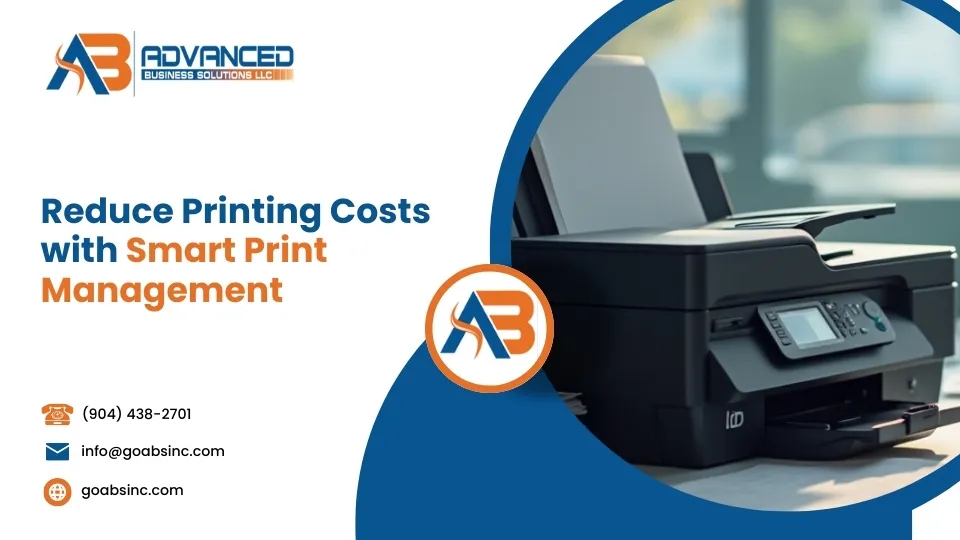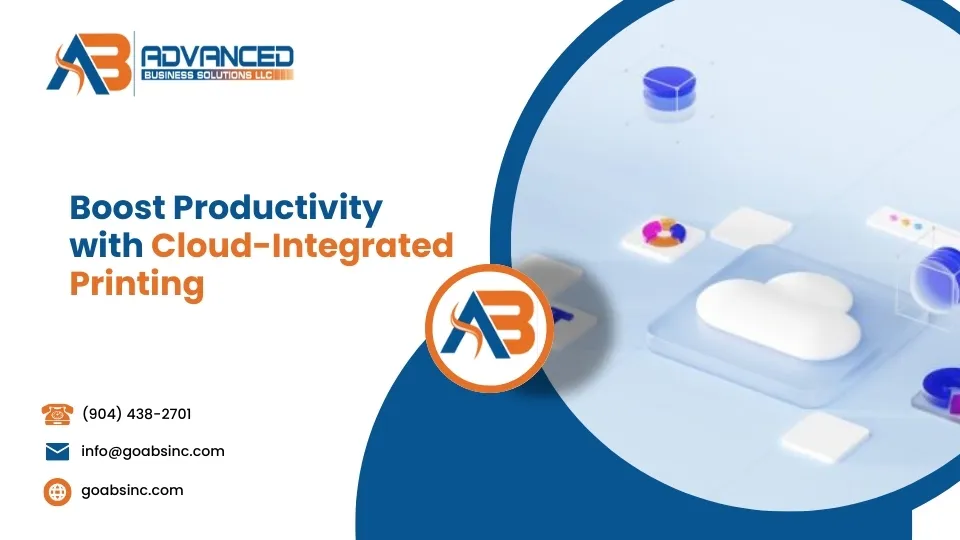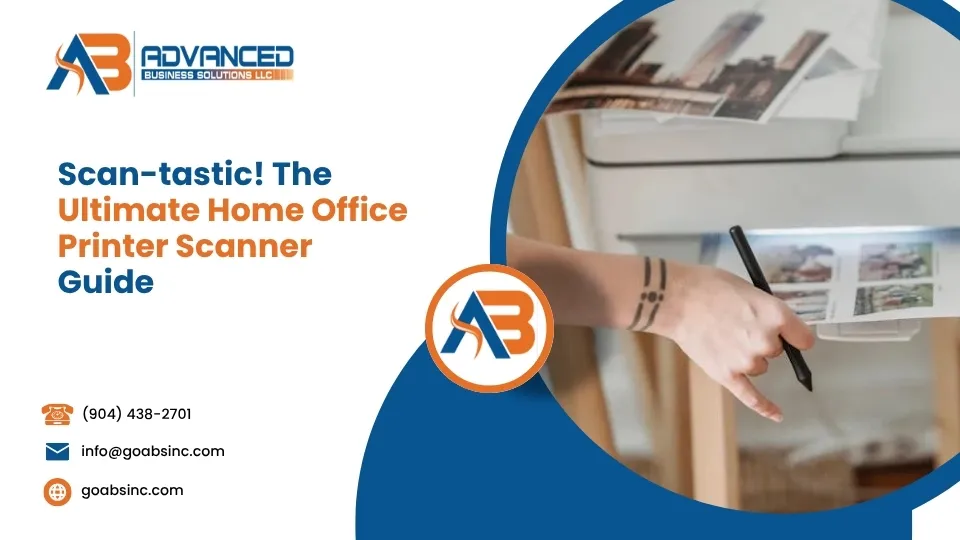Print security is more important than ever for businesses of all sizes. With the rise of sophisticated cyberattacks, unsecure print environments can quickly become entry points for hackers, leading to data breaches, financial losses, and reputational damage. So what can you do to keep your office’s printers secure and your sensitive data safe? Here’s a quick look:
- Evaluate Your Print Environment: Begin by assessing all printers and multi-function devices for vulnerabilities.
- Implement Access Controls: Limit who can access printers and what they can print.
- Update Regularly: Keep firmware and security settings up-to-date.
- Use Managed IT Services: Leverage professional expertise to manage and monitor your print security effectively.
Olivia, an office manager based in Florida, can relate. Working hard to streamline operations and reduce costs, understanding how to secure print environments can help her maintain a smooth and secure workflow.
Print security is not only about protecting print data but also about integrating comprehensive solutions like managed IT services. These services provide tools and strategies that protect sensitive information while also offering a way to automate and streamline office functions.
Security breaches are not just a problem for large enterprises; small to medium-sized businesses are vulnerable too. Many attacks target them specifically due to lax security protocols.
With the help of experts like Advanced Business Solutions, you can ensure your printers and networks are guarded against potential threats. Even a simple device like a printer can be a gateway for cybercriminals if left unprotected.
Understanding Print Security
The Print Lifecycle
The print lifecycle is a critical concept for understanding how to secure your printing environment. It involves three main stages: before printing, during printing, and after printing. Each stage has its own vulnerabilities and requires specific security measures.
Before Printing:
This stage is all about securing your print infrastructure. It’s crucial to control who can access the printers and what they can print. Unauthorized access can lead to data breaches, as sensitive information might be printed by someone who shouldn’t have access to it. Implementing strong authentication and access control measures is essential. For example, using authentication methods such as passwords or ID badges can prevent unauthorized individuals from sending print jobs.
During Printing:
This stage focuses on securing the print workflows. When a document is sent to the printer, it travels through the network, making it vulnerable to interception. Encrypting print jobs ensures that even if they are intercepted, the data remains unreadable. Secure print release solutions, like Find-Me printing, can also help, as they require the user to be physically present at the printer to release the print job, minimizing the risk of sensitive documents being left unattended.
After Printing:
Once a document is printed, it becomes printed output and is at risk of being accessed by unauthorized individuals. To mitigate this, businesses should implement measures such as print log auditing and secure disposal methods. For instance, shredding sensitive documents after use or using watermarking techniques to trace the origin of a document can help protect against unauthorized distribution.
Understanding and securing each stage of the print lifecycle is vital to protecting your business against potential threats. By addressing network vulnerabilities and safeguarding sensitive data, you can prevent unauthorized access and improve your overall print security.
With these strategies, your business can confidently manage print security, ensuring that sensitive data remains secure throughout its journey from digital file to physical document.
Key Strategies to Improve Print Security
To effectively improve print security, it’s important to focus on three main areas: device fortification, document safeguarding, and network defense. These strategies include both foundational and advanced security features that can significantly reduce the risk of data breaches.
Foundational Security Features
Device Fortification
Securing your devices is the first step. Regularly updating printer firmware is crucial to counteract the latest threats. Disabling unnecessary ports and services can prevent unauthorized access. For example, turning off protocols like Telnet and FTP, which are often enabled by default, can close gaps that hackers exploit.
Authentication and Access Control
Implementing strong authentication methods is essential. Require users to log in with passwords or use ID badges to access printers. This ensures only authorized personnel can send print jobs, reducing the risk of sensitive data being printed without permission.
Encryption
Encrypting data as it travels through your network is a must. This means even if someone intercepts a print job, the information remains unreadable. Encryption adds a vital layer of protection, especially in environments where data sensitivity is high.
Advanced Security Features
Secure Print Release
Secure print release solutions, like Find-Me printing, ensure that documents are only printed when the user is physically present at the printer. This minimizes the risk of sensitive documents being left in the output tray for anyone to grab. It’s a simple yet effective way to protect printed materials.
Two-Factor Authentication
Adding an extra layer of security with two-factor authentication (2FA) can further protect your print environment. By requiring a second form of verification, such as a mobile app or a fingerprint scan, you make unauthorized access significantly more difficult.
Digital Signatures
Using digital signatures helps verify the authenticity and integrity of printed documents. This feature is particularly useful in environments where document authenticity is critical, such as legal or financial sectors.
By implementing these foundational and advanced security features, businesses can significantly improve their print security. These strategies provide a robust defense against unauthorized access and data breaches, ensuring that sensitive information remains protected throughout the print lifecycle.
Best Practices for Print Security
Secure Print Management
Ensuring effective print security involves a few key best practices that can safeguard your print environment from unauthorized access and potential breaches. Let’s explore the essentials:
Firmware Updates
Regular firmware updates are crucial. Just like your computer, printers need updates to patch security vulnerabilities and introduce new features. Many security breaches occur because devices run outdated software. By keeping your printer firmware current, you close potential loopholes that hackers might exploit.
Disable Unused Services
Printers often come with a variety of services enabled by default, like Telnet or FTP. These can be potential entry points for attacks. Disabling any services you don’t use can significantly reduce risk. It’s like locking the doors you don’t need, ensuring hackers find no easy way in.
Encrypted Connections
Encryption is a must-have for protecting data in transit. When print jobs are sent over the network, they should be encrypted to prevent unauthorized interception. This ensures that even if someone tries to eavesdrop on your network, they won’t be able to read the data. Using encrypted connections is a straightforward but powerful way to improve print security.
Real-Time Monitoring
Implementing real-time monitoring of your print environment can help detect and respond to issues quickly. By constantly watching for unusual activity, you can identify potential threats before they become serious problems. This proactive approach is vital for maintaining a secure print environment.
Audits and Analysis
Regular audits and analysis of your print environment can provide insights into compliance and security status. By reviewing print logs and usage patterns, you can identify suspicious activities or areas that need improvement. This ongoing analysis helps ensure that your print security measures are effective and up-to-date.
By following these best practices, businesses can create a secure and efficient print environment. These measures not only protect sensitive data but also help maintain compliance with industry regulations. With secure print management, you can focus on your core business activities, knowing your print infrastructure is well-protected.
Frequently Asked Questions about Print Security
How do I secure print?
Securing print involves several straightforward steps to protect your organization from data breaches. Start by changing default login credentials on your printers. Default settings are like open invitations to hackers, so customize them to strengthen security.
Implement a network firewall to create a barrier between your printers and potential cyber threats. This acts as a first line of defense, blocking unauthorized access to your print devices.
Consider using a guest network for visitors and temporary users. This separates their activities from your main network, reducing the risk of unauthorized access to sensitive data.
How do I make sure my printer is secure?
Begin with printer monitoring software. This tool keeps an eye on your printers, alerting you to unusual activities and potential security issues. It’s like having a security guard for your print environment.
Ensure compliance with workplace regulations by establishing clear policies on printer use. Educate employees about the importance of print security and the steps they can take to protect data.
What is a zero-trust design approach?
A zero-trust design approach means never assuming any device or connection is secure by default. Every print request requires user authentication, ensuring only authorized personnel can access sensitive documents.
Incorporate connection verification to scrutinize every connection attempt. This ensures even if someone has access to the network, they still need to verify their identity to use the printer.
By implementing these strategies, you can significantly improve your print security and protect your organization from potential threats.
Conclusion
At Advanced Business Solutions, we recognize the critical importance of print security in the modern digital landscape. Our mission is to deliver comprehensive IT solutions that not only enhance productivity but also safeguard your sensitive data.
We offer a variety of services tailored to meet the unique needs of businesses throughout Florida and the Southeast USA. Our commitment to flexible leasing terms allows you to access the latest printing technology without the burden of long-term commitments, enabling your organization to quickly adapt to changing demands and stay ahead of potential security threats.
Our managed print services are designed to integrate seamlessly into your existing IT infrastructure, helping you establish a more secure and efficient print environment. With features like real-time monitoring, secure print release, and encrypted connections, we ensure your data is protected from unauthorized access.
Advanced Business Solutions is dedicated to providing expert guidance and cutting-edge technology. Our focus on security, coupled with our commitment to customer satisfaction, positions us as the ideal partner for all your print and IT needs.
To learn more about how our managed print services can benefit your business, visit our Xerox Managed Print Services page. Let us assist you in enhancing your print security and preventing data breaches today.













Comments are closed